The Garden Route, a coastal stretch of land in South Africa, is one of the most beautiful and diverse regions in the country. With its stunning beaches, towering mountains, lush forests, and winding rivers, it’s no wonder that the Garden Route has become a popular destination for tourists from all over the world.
The region is known for its natural beauty and is home to some of the most stunning scenery in Africa. From the picturesque beaches that seem to go on forever to the rolling hills of the Klien Karoo, the Garden Route offers an unforgettable experience for adventure seekers, nature lovers and beach bums alike.
Whether you’re looking for a relaxing beach holiday or an adrenaline-filled adventure, whether you want to frolic in the waves or climb the highest peaks, you’ll be sure to find it here. From paragliding in Wilderness to spelunking in Oudtshoorn, from bungi jumping in Nature’s Valley to relaxing baths in the Warmwaterberg the area is truly littered with hidden gems and secret spots waiting to be explored.
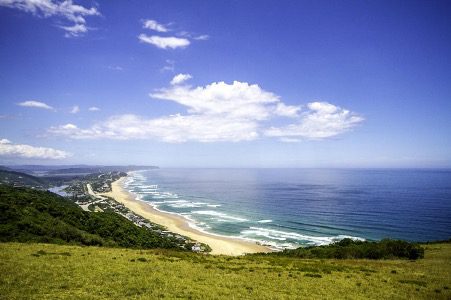 View of Wilderness Beach
View of Wilderness Beach
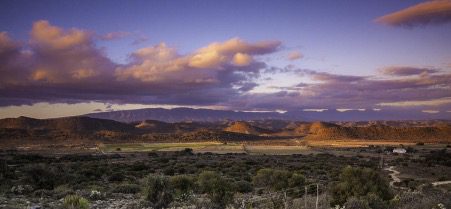 Klein Karoo as seen from Warmwaterberg
Klein Karoo as seen from Warmwaterberg
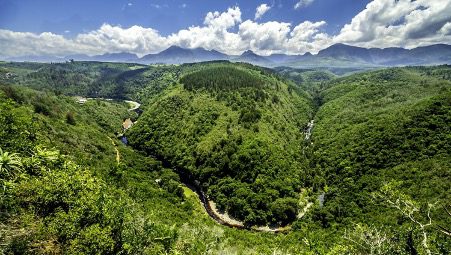 Map of Africa in the Wilderness
Map of Africa in the Wilderness
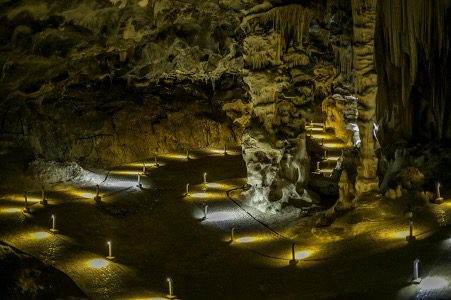 Cango Caves
Cango Caves
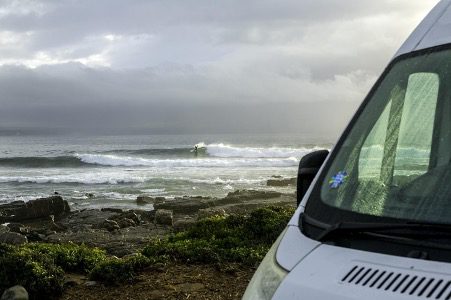 Playing in the Waves at Stilbaai
Playing in the Waves at Stilbaai
With so much on offer it is easy to miss one of the most fascinating aspects of the Garden Route. Hidden in coastal caves and mountain crevices is a history lost in the archives of a tumultuous past. It is the history of the first inhabitants of Southern Africa, the people who are today referred to as the San. To venture into this history is to gain a new understanding of what it means to be human and our place on this planet. To reconsider our beliefs and how we treat one another and the world around us. Though be warned, if you start on this journey, it may leave you wanting, craving and scratching for clues to piece together a history once forgotten, often leaving one frustrated with how little we actually know of this world.
A fantastic place to start on this journey is by downloading the The History of South Africa podcast by Desmond Latham in your favourite podcasting app.
As the city fades into the distance behind you and Desmond’s calm voice describes these early inhabitants, it isn’t a far stretch to imagine oneself as one of these nomadic people heading off to find a new place to set up camp. Some 100000 years ago this is exactly what people did in an area near Stillbaai where ancient artefacts have been found in the Blombos Cave (https://en.wikipedia.org/wiki/Blombos_Cave). Here there is evidence of some of the first art ever created by human kind and while it is not possible to visit the cave itself there is a fantastic exhibition at the Blombos Museum of Archaeology in the Stillbaai information centre. Having taken in the museum it is easy to find oneself sitting in the shade of the trees at the cafe, contemplating how art has been used as a form human expression over the centuries. From “simple” lines in the sand to rock art and cave paintings that were used to convey information about the environment, as well as to represent spiritual beliefs. Throughout the classical period, art was used to communicate stories, express ideas, and reinforce ideals. During the Renaissance, art became associated with patronage, and the focus shifted from religious and spiritual subject matter to learning and culture. In the modern era, photography, film, and digital technology have become important tools for creating art. The rise of modernism and its emphasis on abstract, non-objective interpretations of reality have also had an influence on art and with it how we see ourselves and the reality we exist in. Today as technology continues to evolve and software is producing more and more of our art, how will this shape our cultures going forward and what role will art play in our societies, what role will we play in creating art? Could these first peoples ever have imagined that the marks they left behind (https://phys.org/news/2021-04-triangular-patterns-reveal-human-ancestors.html) would still be there to shape the future of their descendants?
 Stilbaai Info Centre & Museum
Stilbaai Info Centre & Museum
 Stillbaai Point
Stillbaai Point
Also at Still Bay are stonewalled fish traps represent the technological and economic evolution of early fishing practices in the area. These traps were built at the correct height to trap fish during a falling tide. They illustrate a traditional fishing method along the Southern Cape coast that endured through the ages and show how these people must have watched and worked with their environment. Indeed much of what we know about them shows that they viewed themselves as part of nature not separate from it.
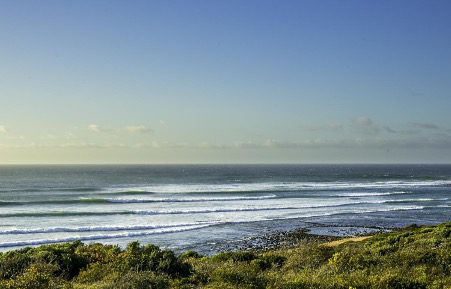 Fish Traps at Low Tide
Fish Traps at Low Tide
A few hours drive further down the coast in a rather unexpected setting lies a site where some of the earliest evidence for modern human behaviour has been found. Discoveries here have pointed to that for possibly the first time in the archaeological record the use of fire for the heat treatment of rock to make stone tools. To get to the site at Pinnacle Point (www.humanorigin.co.za) is to take a tour through a modern human settlement in the form of a golf estate with huge mansions and glass fronted clubhouses. A wooden stairway leads up to the cave from where a view of the Indian ocean sprawls out in front from its gaping mouth. Though it is speculated that some 100000 years ago when our ancestors where just learning to manipulate matter that this view was that of a savanna with the ocean some 5km away. It is incredible to think that human kind has gone from roaming the wilds and temporarily settling in caves such as this, which afforded us the safety and security to learn to use fire’s energy and manipulate objects, to building giant structures made of materials we created through alchemy passed down from our forefathers. To think that the only way any of this was possible was through working together and sharing knowledge passed down over generations. Standing on the cliff seeing the caves below and the estate above is to see a timeline of how societies have evolved and grown, it is to stand and wonder where is it all going, what will we be building in a 1000 years from now and what from today will still be standing to remind our descendants of where they came from?
Leaving Pinnacle Point the rocky shoreline makes way for a huge sandy bay known as Mossel Bay. This was the location where cultures would collide when the first Europeans, the Portuguese, arrived in the 1400s and encountered the people’s inhabiting this coast. A visit to the Diaz Museum Complex (https://www.diasmuseum.co.za) is to thrust oneself into this time period. Standing on the deck of the huge ship which makes up the centre piece of the museum, it is not a far cry to imagine oneself anchored in the bay after months at sea, looking to the shore for some relief to spy figures moving between the shrubs. And what about being one of those on the shore, seeing this giant floating object arrive in your fishing grounds. It is unfathomable to think how these first interactions took place, when neither party could understand the other and how, from this first meeting a dance of cultures started, one that is still playing out today.
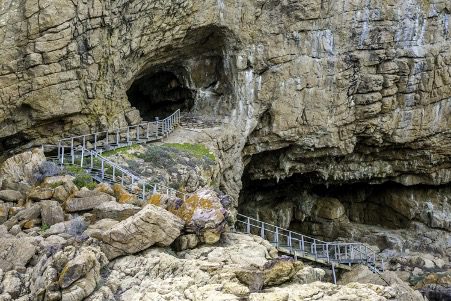 Entrance to Pinnacle Point Cave
Entrance to Pinnacle Point Cave
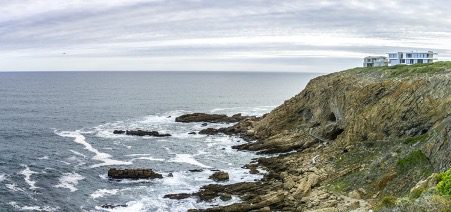 View from the cliffs at Pinnacle Point
View from the cliffs at Pinnacle Point
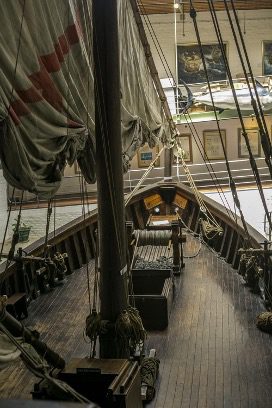 On deck at Diaz Museum
On deck at Diaz Museum
Further east the scrub turns to thick bush and eventually evergreen forests, where elephants once roamed. This area is also referred to as Eden. It is not difficult to see why when driving the lush mountain passes and the coastal towns and it is no wonder that with all the nature around it has become home to one of the largest Rastafarian communities in South Africa. Just outside of Knysna is Judah Square, a thriving and vibrant community that has a strong connection to the Khoisan people, who are the first people of the area. The Rastafarians have adopted many of the traditional practices of the Khoisan, such as their language, music and dance. The community has also had a marked impact on the surrounding area which leaves one feeling like there is something different, something magical about this region.
Deeper into the forests lies more ancient history such as Nelson Bay Cave (https://en.wikipedia.org/wiki/Nelson_Bay_Cave) in Plettenberg Bay, which is one of the most incredible places to explore. It is a limestone cave, located in the Tsitsikamma mountains, which is a protected area. The cave consists of three impressive chambers, which are divided by narrow passages which are lit up by natural sunlight. The chambers are filled with fascinating stalactites and stalagmites that have been formed over millions of years, as well as an underground lake. The cave show’s evidence of habitation some 125 000 years ago with graves found near the mouth of the cave, the remains of which being in a fetal position, and decorated with shells and ochre. Another being the UNESCO World Heritage Site, Klasies River Caves (https://en.wikipedia.org/wiki/Klasies_River_Caves) which is known for its significant archaeological findings. The cave system consists of three main caves and several smaller ones. These caves are believed to have been used by humans roughly between 115,000 and 30,000 years ago. Inside the main caves, one can see the remains of stone tools and a variety of animal bones. The smaller caves contain additional artefacts, such as pottery and rock art. The Klasies River Caves are a stunning reminder of the past, and a visit is an unforgettable experience.
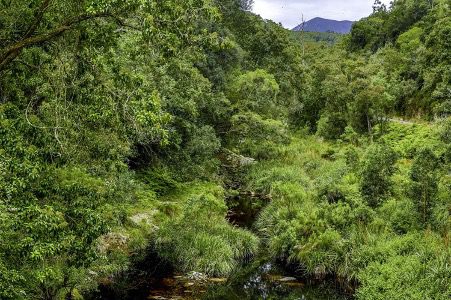 Thick forest on the 7 Passes Road between George and Knysna
Thick forest on the 7 Passes Road between George and Knysna
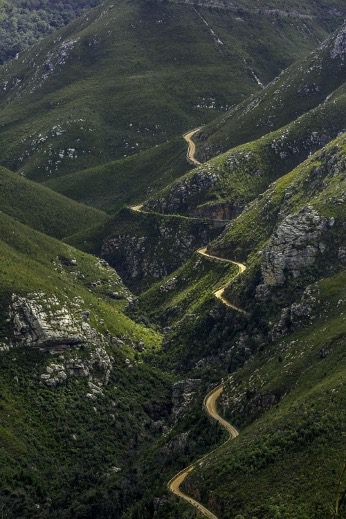 Montague Pass
Montague Pass
These sites are but a glimpse into a past that was but the beginning of a series of migrations that humans would make to South Africa. They are part of a deep and varied history of not just the Garden Route, but the human species. Just as these first peoples arrived from the African interior so too would Bantu speaking people, bringing with them new art, cultures and technologies. Later Europeans would return to Africa, the continent from which they originated, and make their way inwards from the coast, again brining different cultures and technologies. One technology was the wheel, which made it possible to move heavier and larger loads, to build larger settlements and more advanced infrastructure. Though it was by no means an easy task. As one heads back towards the Cape it is possible to turn inland driving the winding Outeniqua pass where view stretches out over undulating green mountains with deep earth coloured veins. These veins are the tracks left behind by those wheels, grooves cut deep into the rock as wagons were dragged up the steep crevices by weary oxen. At the end of one of these veins, the Montague pass is a heritage site that few know of and even fewer have seen. Hidden above the vineyards of Herold Wines (https://heroldwines.co.za/) is perfectly preserved rock art. A truly special experience is to grab a bottle of their wine and hike up to these paintings with a picnic. Sitting on the boulders under the paintings with the vines stretched out in front, surrounded by ragged peaks, it is as if one is straddling two worlds that are about to collide. Sitting there taking it all in, reminiscing of the history that has come to pass is to be reminded that in this time of seemingly intense cultural differences and national identities, that we all originated from the same place, that culture is constantly evolving and the best we can do is to evolve with it. What better way to do so than to hop in a van and thrust oneself into different experiences, to take the best of them and learn from the bad?
 Rock Art at Herold Wines
Rock Art at Herold Wines
 View from Herold Wines
View from Herold Wines
About Author
Mark is a gypsy photographer traveling the world in various forms. Currently via a self-converted electric sailboat. See his work and get in touch: https://unsplash.com/@luckybeanz
Back